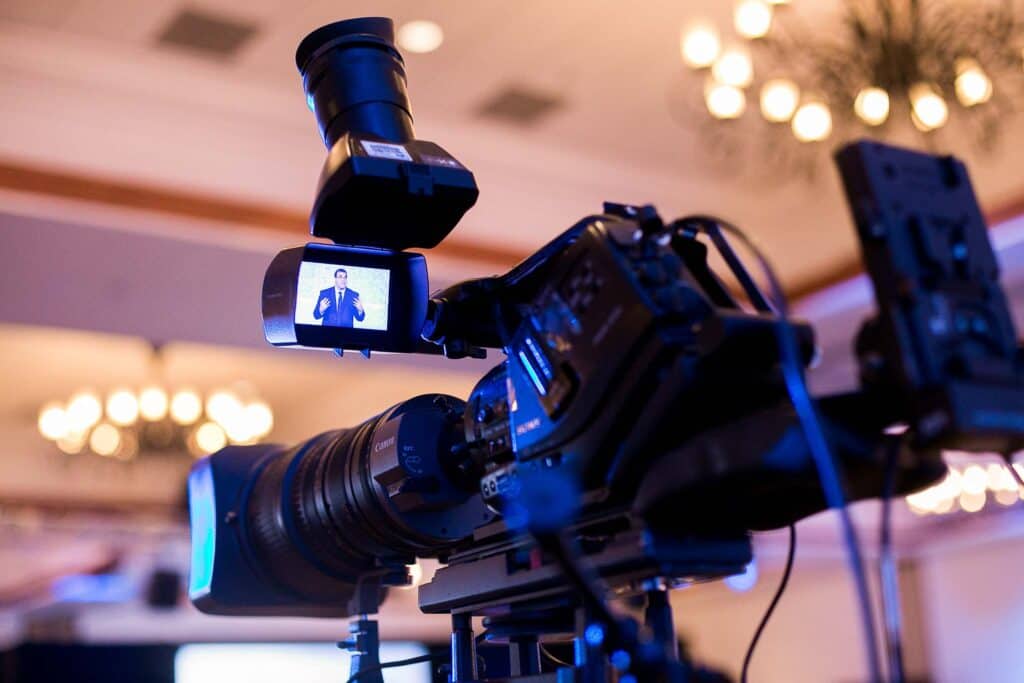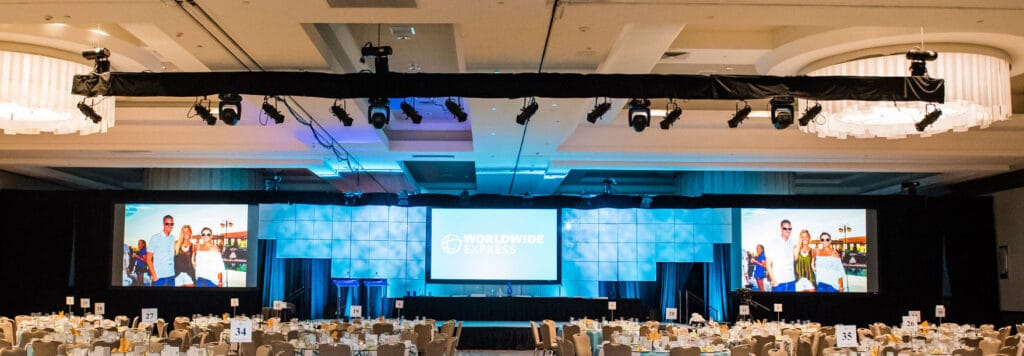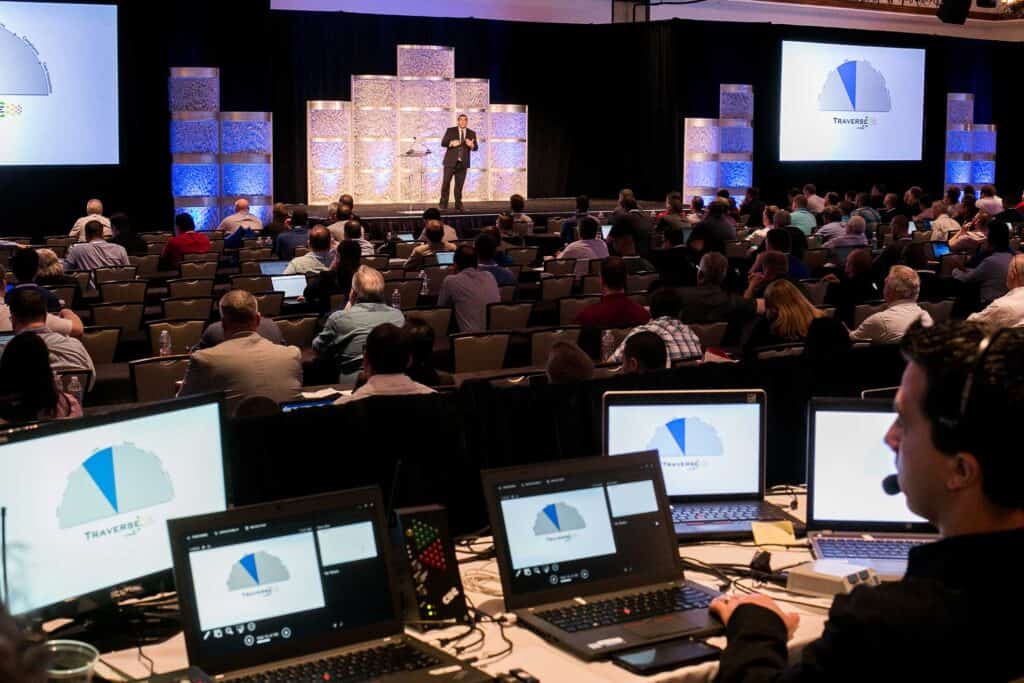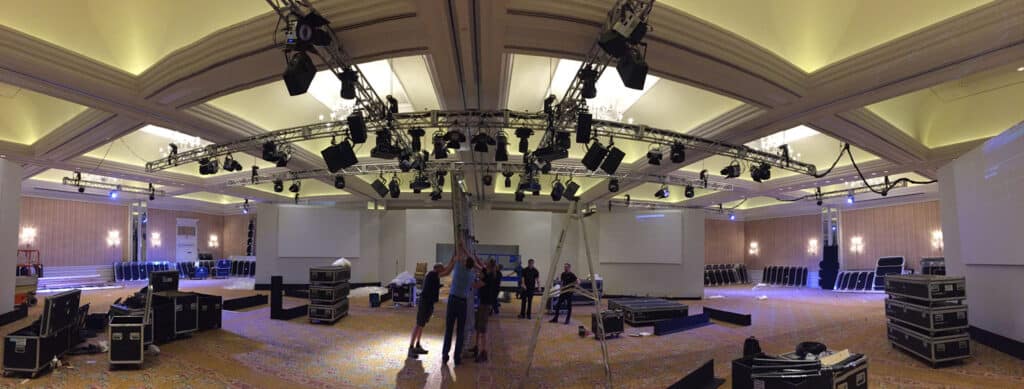Even if you’re in the right mindset, ready to learn, and committed to seeing your event succeed – and honestly, if you’re here reading this, that’s a fair assumption – truly understanding your event’s audio visual technology can be challenging. With so many moving parts comprising the sights, sounds, and experiences that you’re eager to convey to attendees, it’s completely understandable if there are a few terms you don’t recognize yet. Thankfully, there’s still time before your event to brush up on the basics of AV technology. A quick study session will enable you to not only navigate your event’s needs like an industry pro, but also understand the nuances of business contracts for AV service at your venue of choice. But before we jump into technical AV technology terms, let’s answer the very basic questions.
What is AV & AV Technology?
AV is an abbreviation for Audio Visual, which is used to describe electronic media that possess an audio (sound) and visual (sight) component. AV technology refers to the actual equipment or tools that convey these components, such as lighting, projectors, speakers, and displays.
The Pre-Show: Audio Visual Equipment Considerations
While it might be tempting to jump right into the proverbial wires and plugs of navigating event audio-visual equipment, it’s not where you should start. To better understand what AV technology can do for your event, you need to know how you’ll get it all in, out, powered, and connected for use during the event.
Below, some common client scenarios and industry terminologies to familiarize yourself with AV equipment and related pre-show AV services:
Scenario 1: “We sent the exhibitor order form to the keynote speaker and discovered he needed another microphone.”
- Exhibitor Order Forms: While you undoubtedly have a vision for your event, remember that it isn’t a given that every presenter shares your exact idea of adequate audio-visual coverage. An exhibitor order form is essentially a list given to your speakers prior to an event, asking them what specific technology they’ll need to deliver a smooth, clear presentation to your attendees.
Scenario 2: “We’re planning the load in at 8 am, starting at the loading docks in the rear of the building.”
- Load In / Load Out: These terms refer to one of the most important aspects of setting up audio-visual equipment for an event – and believe it or not, they start before a plug ever finds an outlet. Physically moving in speakers, screens, projectors, and control systems at the right time and place is the effort that will keep your event on-track and on-schedule.
Scenario 3: “We felt pressured to use the in-house supplier, but went with a great third-party provider that had the colored LED light wall that we wanted for the big speech.”
- In-House Supplier / Third Party Provider: Many larger venues offer either an in-house audio-visual team or have a preferred provider ready to recommend if your event needs one. While there are benefits to both approaches, third-party providers – those that aren’t built into the venue – often offer access to more innovative technology solutions, as they aren’t restricted by the venue budget. The other side of the coin is that they may be less familiar with the venue and its capabilities – an obstacle that’s easy to overcome, however, with enough time for research.
Fine Tuning: Physical AV Components
It’s not all screens and wires – a complete event audio visual setup requires a lot of support of the physical variety as well. Depending on the height, width, and power capabilities of a given venue, you might require all of these elements to have adequate AV coverage for your audience. Read on to learn more about the subtle nuances of physical AV components:
Scenario 1: “When we needed the sounds of the video to reach the back of the auditorium, suspension rigging for the speakers helped our team achieve better acoustics for the entire room.”
- Rigging: You’ve probably heard of this word in conjunction with ropes or sailing ships. In an AV context, it points to the equipment providers rely on to suspend components, such as projectors, microphones, speakers, or lighting, from the ceiling of a venue or room. Most large-scale setups will need some sort of rigging, so be sure you have information about maximum ceiling height or load-bearing weight to pass on to your audio-visual services provider.
Scenario 2: “The trusses gave us the ability to make a “backstage area” right on stage so the presenter could line up her various props out of the audience’s line of sight.”
- Truss: While technically a component of overall rigging, these aluminum tubes assist with non-AV related stage dressing needs, such as supporting drapes and props, as well as wires and lights. Trusses typically break down for easy transport, but will require extra load-in and load-out time to set up and take down after an event.
Scenario 3: “The front of house setup was surprisingly compact given the auditorium’s square footage, and left plenty of room for adding additional audience seating.”
- Front of House: This is a shorthand term for “where the AV team will set up their control center.” It’s most often found against the front entrance wall of a presentation space, ideally to the far left or right of the door to stay out of the way. It is typically positioned facing the stage for visual cues and monitoring.
The Warm-Up: Audio Visual Technology for the Masses
The main stages and meeting rooms are set up, and you’re starting to feel confident about the direction of your event. Now is an important time to remember that your attendees aren’t just interacting with audio-visual technology in sit-and-watch sessions, speeches, and classes – they’ve all come with their own technology, such as smartphones, tablets, and laptops, ready to hashtag, post, and share. The better they’re able to use those tech tools, the better your event will look to potential attendees for next year’s event on social media. Leverage the latest technology that’s available and take your event to the next level. Below, a glossary of the tools of the trade to keep top of mind when orchestrating your next corporate event:
Scenario 1: “When the speaker suggested session attendees bookmark her website mid-presentation, the audience was grateful that the event’s sponsored WiFi gave them fast access to the page.”
- Sponsored Wi-Fi: All of those attendees need to be able to access the internet in order to post, visit websites that speakers suggest, and so on. Sponsored wifi gives them that option and gives you a valuable chance to share your own brand or sell placement for another at the same time. Not all venues have this capability, so be sure to check your en masse internet options well before your event to avoid unpleasant breakouts of “low bars syndrome” and frustrated guests.
Scenario 2: “We couldn’t find a flight out to the conference, but thanks to live streaming from the session, we were able to watch the once-in-a-lifetime interview from our favorite author from our home computer.”

- Video Conferencing / Live Streaming: Advances in audio-visual technology for events have enabled organizers to reach bigger audiences than ever before, even if they aren’t physically present. “Streaming” technology refers to combinations of components that record and broadcast a live feed or audio and video to the internet as it’s physically happening elsewhere. This can be used to send out an event session to members across the world, or to bring a guest speaker onto an event screen for a local audience if he or she is unable to physically attend. Holding a video conference allows participants from all over to communicate with each other in real-time through sound and vision. Some events even use these methods to monetize their sessions by streaming individual informative sessions and offering certification classes afterwards.
Scenario 3: “She had a great question for the presenter, but she should have had a wireless microphone because the back rows couldn’t hear what she was asking.”
- Wireless Microphones: While this term is a little self-explanatory, many event organizers incorrectly believe that individual presenters and speakers are the only ones that need wireless microphones. Audience interactions drive engagement at events, so in addition to the familiar tiny mic clip / battery belt clip combinations, be sure that you have a wireless microphone option that can be passed through the audience for questions and comments that all can listen and respond to. Encouraging communication from both sides is extremely important for engagement and collaboration.
The Main Event: Audio Visual Equipment Done Right
Now that you’re set up and connected to your audience, it’s time to “seal the deal” with an above-the-bar AV presentation. Crisp, clear images that put every PowerPoint slide in the spotlight, and audio that’s loud enough to hear – but not so loud that every ‘S’ sounds like snakes have escaped from the podium.
While there is no universal list of settings to ensure perfection at every event and every venue, there are a few areas of focus that you can’t afford to overlook when it comes to your AV event setup:
Scenario 1: “When the older screen only offered a 4:3 aspect ratio and the presentation was displayed in 16:9, the attendees seemed to stare more at the ugly black bars than the speaker.”
- Aspect Ratio: These numbers, typically presented in an X:Y format, correspond to the proportion of a screen’s width to its height. In other words, if the ratio of your projectors doesn’t match up with the screens they’re projecting on, you’ll either get an image that will have black bars across the top and bottom, or along the sides of the image or video. Either way, it paints a distracting picture for the audience and could potentially cause the message to be lost in proverbial translation. Make sure to adjust either component accordingly to make certain your displays look professional and clear.
Scenario 2: “The clarity offered by HDMI cables is the difference between a clear, high-definition movie played on a flat screen and the same movie played on a grainy, old-fashioned television.”
- HDMI: Most people are familiar with this acronym from home television and computer monitor hookups, but it’s especially important during large-scale events. Short for High Definition Multimedia Interface, HDMI cables and ports are the go-to for all professional display and sound needs in the event sphere. In addition to the cables and connectors that will come with your audio-visual provider’s equipment, make sure to keep dongles and adapters on hand for common devices so your presenters always have a ready AV solution for displaying or playing files.
Scenario 3: “The speaker was able to relax and connect with the audience because he knew he could rely on the audio visual technician to follow the cue-to-cue faithfully.”
- Cue-to-Cue / Run of Show: Your AV team needs to know when to cue up lights for presenters, when to start and stop certain AV aspects like music or video, and sometimes even when to change PowerPoint slides. A cue-to-cue or run of show script lays out each change in an easy-to-follow format so that your session presenters and keynote speeches look polished and professional.
Scenario 4: “Thankfully, the nervous performer was able to reassure himself that his tie was on straight with a quick glance down at the confidence monitor on stage.”
- Confidence Monitor: This unique piece of audio visual for events is one of the few that isn’t set up with audience consumption in mind. This small screen is typically mounted flat or at a slight angle on the front of a stage, facing the performer or speaker. Through the use of Image Magnification (I-Mag), it allows him or her to get a quick glance at what they look like to the audience, allowing them to adjust accordingly – clothes, facial expressions, gestures, and so on – if needed. Additional uses of confidence monitors is to display presenter notes, or the master PowerPoint slides so that the presenter needn’t turn around to see what is on the screens.
 Summary
Summary
While your event will undoubtedly have its own unique range of audio visual technology, these common devices, components, terms, and practices will ensure that you know where you stand from the start. After all, what is audio visual technology if not a tool to make your event the best it can be? Discuss your needs, expectations, and event vision with your audio visual services provider and two things will become perfectly clear: your displays and sound quality, of course! Searching for a San Diego audio visual company for your next big event? Don’t hesitate to connect with us to discuss how we can help support you and your event.








